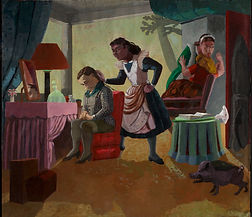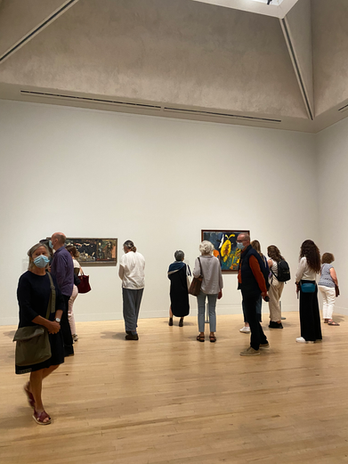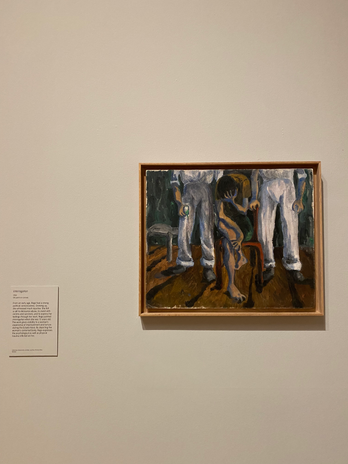Painter’s Forum:
Michael Ajerman on the work of the artist Paula Rego
Images taken at the exhibition on 5/8/2021
Painter’s Forum
Michael Ajerman on the work of the artist Paula Rego
15/11/2024 Camberwell College of Arts
To begin with, Ajerman asked whether we had visited Paula Rego’s retrospective at Tate Britian in 2021. I immediately recalled being overwhelmed by the extensive collection on display that day. Also, it was mandatory to wear a face mask in the exhibition as the exhibition happened during the covid pandemic, making it more unforgettable.
In the talk, Ajerman mainly focused on introducing some techniques Rego had used; for instance, he shared Rego’s academic background and explained how the “Slade technique” had subsequently influenced her portraits and observational paintings. He analysed where Rego’s inspirations and references were coming from; for example, Rego added characters from folk tales in her artistic commentary, using them as a metaphor to challenge the society and its political issues.
Ajerman shared that Rego’s artistic process often involved inventing characters by drawing inspiration from photographs and combining them with her imagination. For instance, according to Ajerman, The Maids (1987) (see figure 1.) was inspired by Susannah York’s 1975 film (Gibson, 2022) of the same name, which Rego referenced extensively in her paintings.
One of the prominent paintings we looked at during the session was The Dance (1988) (see figure 2.), a piece depicting people dancing in a circle under the moonlight. While it looks very romantic at first glance, it carries a sense of poignancy. Rego created over a dozen drawings and sketches for this painting in just six months, depicting herself dancing with her husband. Tragically, her husband passed away before the painting was completed. (Tate, 2024)
A remark from a previous reading group with Gavin Edmonds, as he mentioned, “Artists see paintings in a painting,” further enriching the layers of meaning and connection in the art. To me, The Dance (1988) also evokes connections to Salman Toor’s Ghost Ball (2023) (see figure 3.). The Parkistani artist often addresses societal homophobia and portrays the vulnerable in his paintings. The green background in Ghost Ball (2023) creates an otherworldly nocturnal atmosphere (see figure 4.), and the skull in the foreground stands for “memento mori” (“remember you must die”), a reference to the tradition in art history. (Tate, 1997) Toor’s works, like Rego’s, layer metaphor and symbolism, invites viewers to explore deeper beneath the surface, and also inspire me to incorporate similar techniques – layering metaphor and symbolism – to communicate nuanced ideas.
Reference:
Gibson, D. (2022) Those gloves again! (Madame will wear red) - Susannah York, Glenda Jackson in Jean Genet’s The Maids, YouTube. Available at: https://youtu.be/oxtXKL18X1s?si=aILcU81sPEuAKUf6 (Accessed: 20 January 2025).
Narrative Painting (2024) Paula Rego, the Maids, 1987, Narrative Painting. Available at: https://narrativepainting.net/paula-rego-the-maids-1987/ (Accessed: 20 January 2025).
Tate (1997) Memento Mori, Tate. Available at: https://www.tate.org.uk/art/art-terms/m/memento-mori (Accessed: 20 January 2025).
Tate (1982) ‘the dance’, Paula Rego, 1988, Tate. Available at: https://www.tate.org.uk/art/artworks/rego-the-dance-t05534 (Accessed: 20 January 2025).
Tate (2024) The story of Paula Rego’s ‘The dance’, Tate. Available at: https://www.tate.org.uk/art/artists/paula-rego-1823/the-story-of-paula-regos-the-dance (Accessed: 20 January 2025).
Thomas Dane Gallery (no date) Salman Toor, Thomas Dane Gallery. Available at: https://www.thomasdanegallery.com/artists/366-salman-toor/profile/ (Accessed: 20 January 2025).

Figure 1. (Narrative Painting, 2024)
Paula Rego
The Maids
1987

Figure 2. (Tate (1982) )
Paula Rego
The Dance
1982
Acrylic paint on paper on canvas
212.6x274cm
.jpg)
Figure 3. (Thomas Dane Gallery (no date)
Salman Toor
Ghost Ball
2023
Oil on linen
190.9x323.2cm
Susannah York’s The Maid (1975) Click to redirect to play.


















